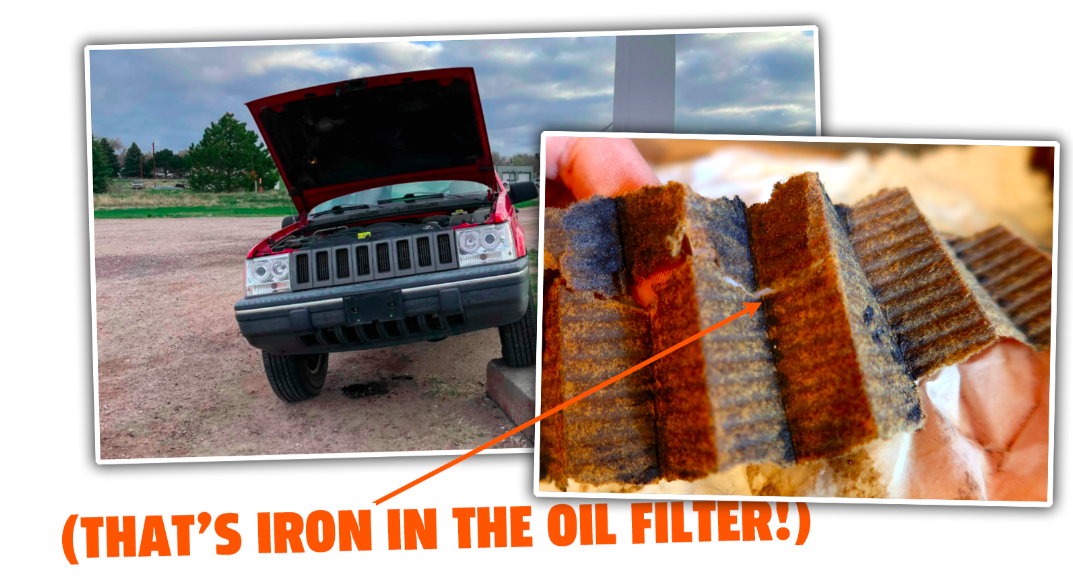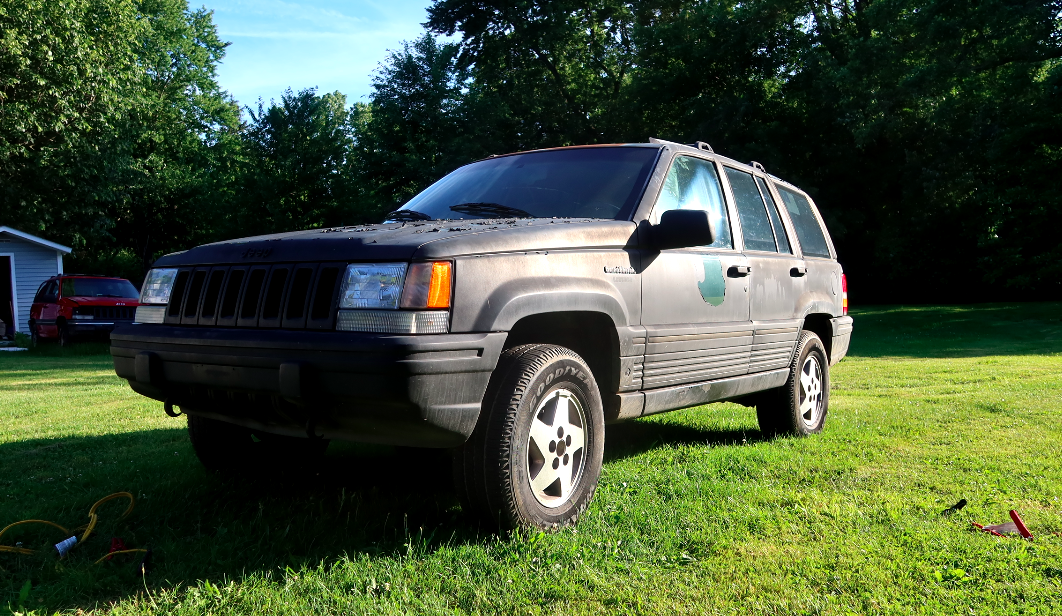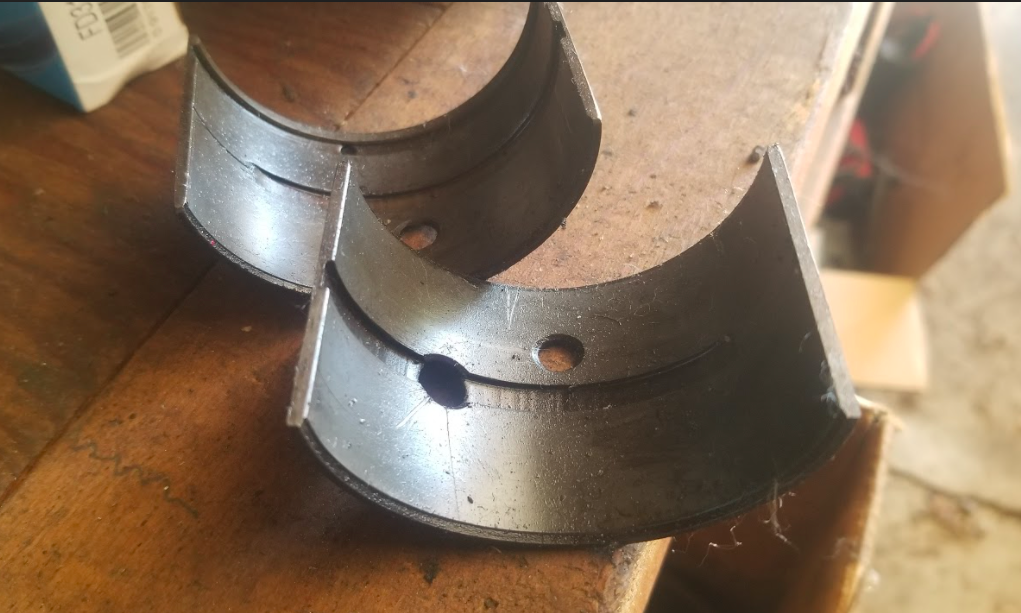My Car Ran Low On Oil. Here Are The Tests I Ran To Assess The Damage
The engine nearly ran out of oil. To see how doomed it is, I did some tests and talked with an expert
My 1993 Jeep Grand Cherokee's oil pressure sensor broke, shooting 10W-30 all over the highway, leaving the engine dangerously low in lifeblood. My colleague Bradley, who was at the helm, dumped in gallons of oil to make up for the bleeding before coming up with an ingenious fix. Still, I was worried that my engine might have suffered permanent damage, so I ran some tests. Here's what I found.
My fleet of cars may not be pretty, but I take a lot of pride in keeping the rough-around-the-edges machines in excellent mechanical shape. So when my coworker Bradley texted me "Hey David, call when you get a chance" during his road trip in my 1993 "holy grail" Jeep Grand Cherokee, I was alarmed. He explained to me over the phone that the vehicle was leaking oil profusely, and that — after pouring over five gallons — he'd run out of make-up oil to keep up with the leak. He said he was in the middle of nowhere.
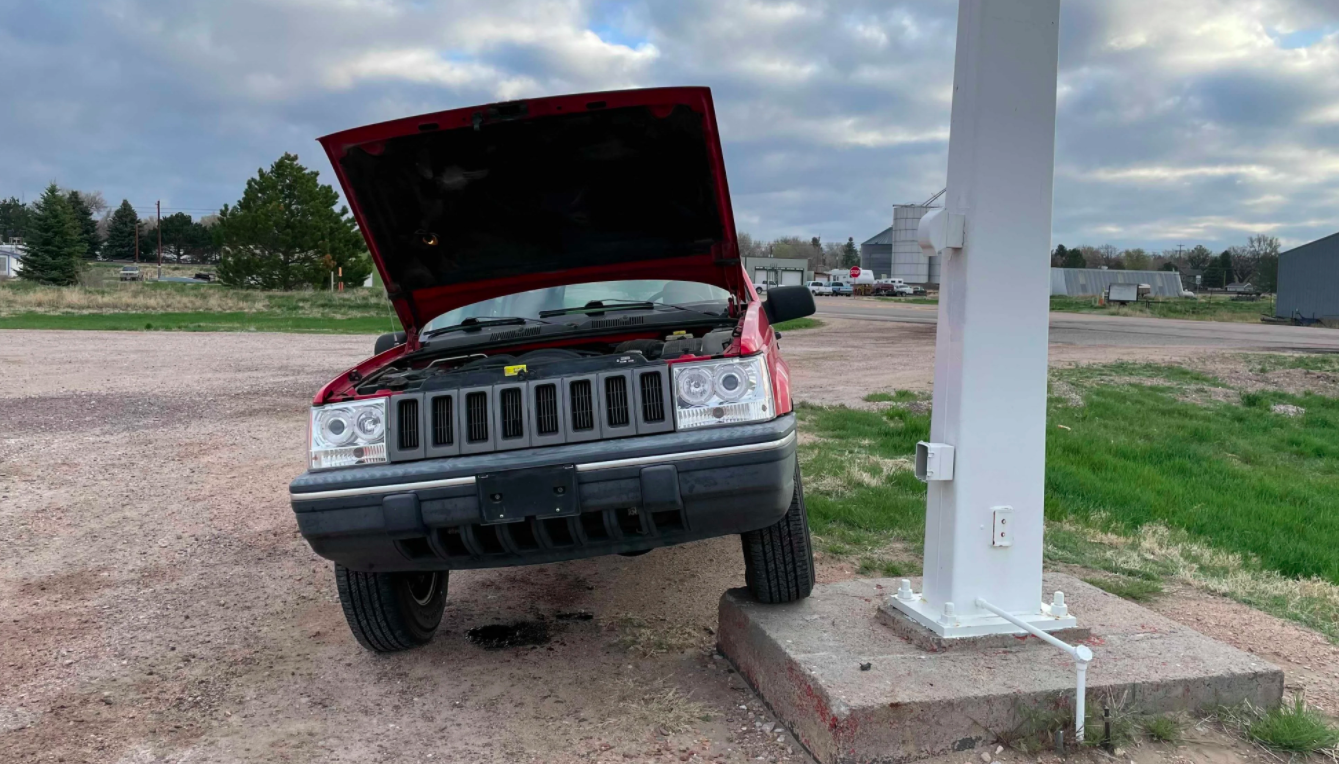
I had no other choice but to answer something to the effect: "Just limp it to the next town. Keep speeds down, and pay attention to how the engine sounds. When you get to the store, fill the crankcase with some cheap oil and try to plug the hole." So that's what Bradley did. Here's his janky but effective fix:
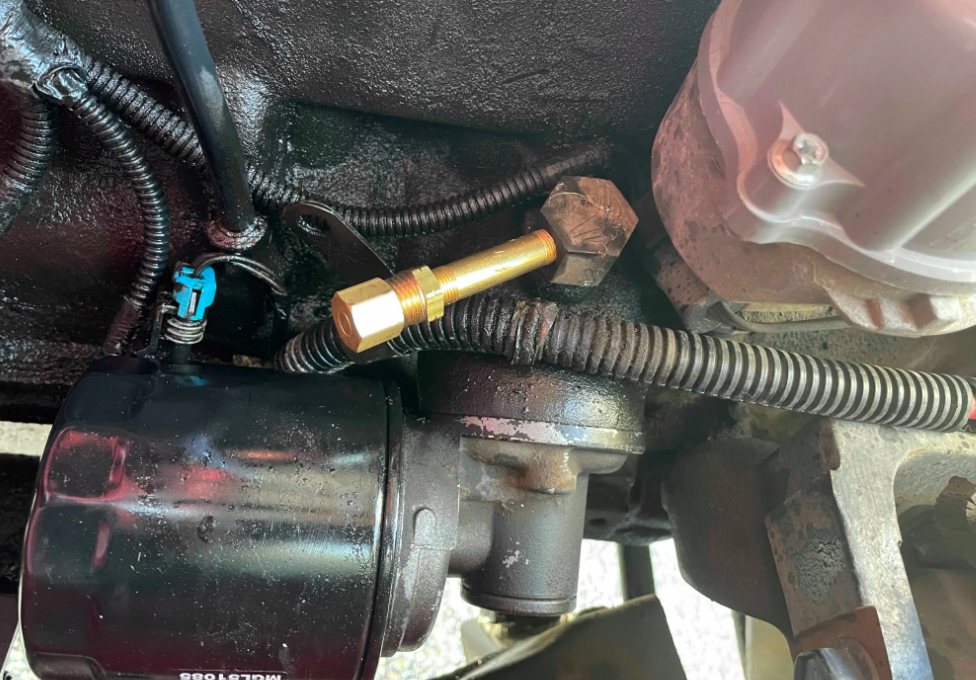
Bradley arrived in Michigan a few days later, and introduced me to the incredible, rust-free, manual transmission, base-model 1993 Jeep Grand Cherokee. It's amazing, even if its driver-door won't close.
Despite being smitten with the red, fully coil-sprung beauty, in the back of my mind I was worried that the vehicle's young 125,000-mile heart may not last the 500,000 miles that it should. So when I got home, I did an oil change, tore into the vehicle's filter, and sent off a sample of the old oil to Blackstone Labs for analysis.
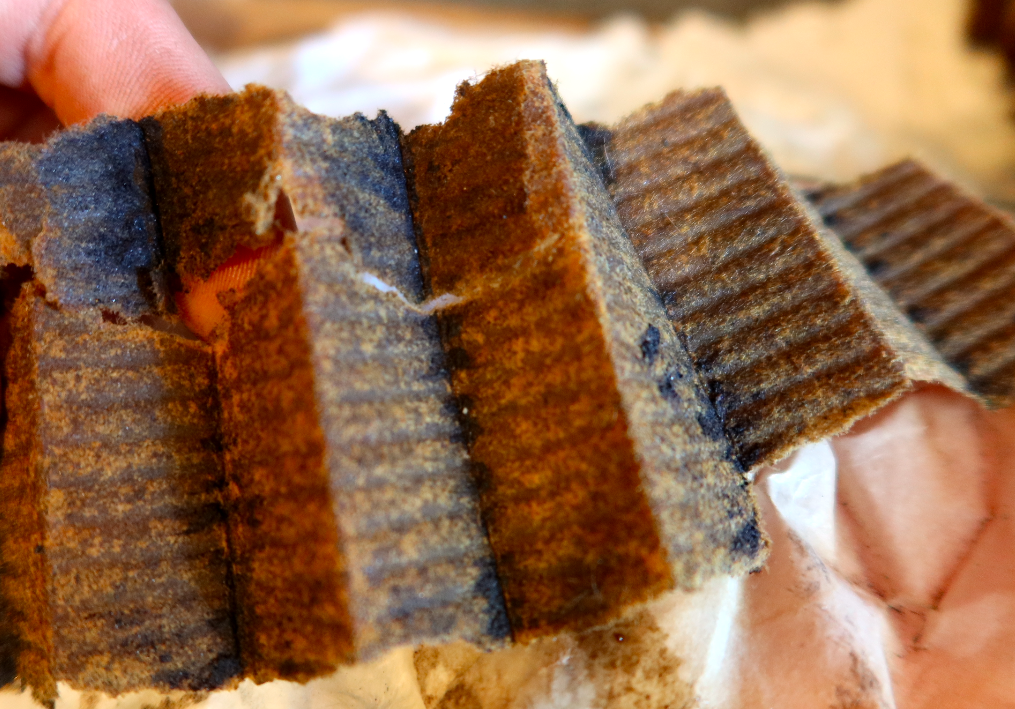
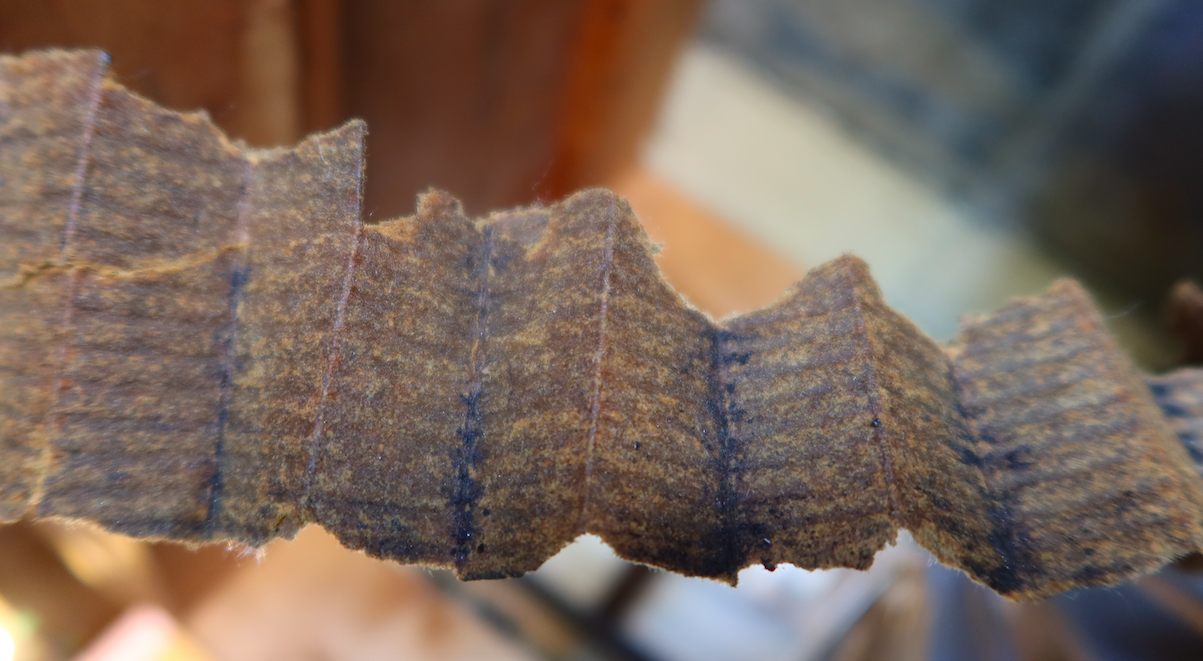
In the filter media I found lots of small black particles, many of which were ferrous, as they stuck to my magnet. Other than these black specs in the crevices of the paper media, the filter looked good, and so did the oil, though Blackstone's report begs to differ.
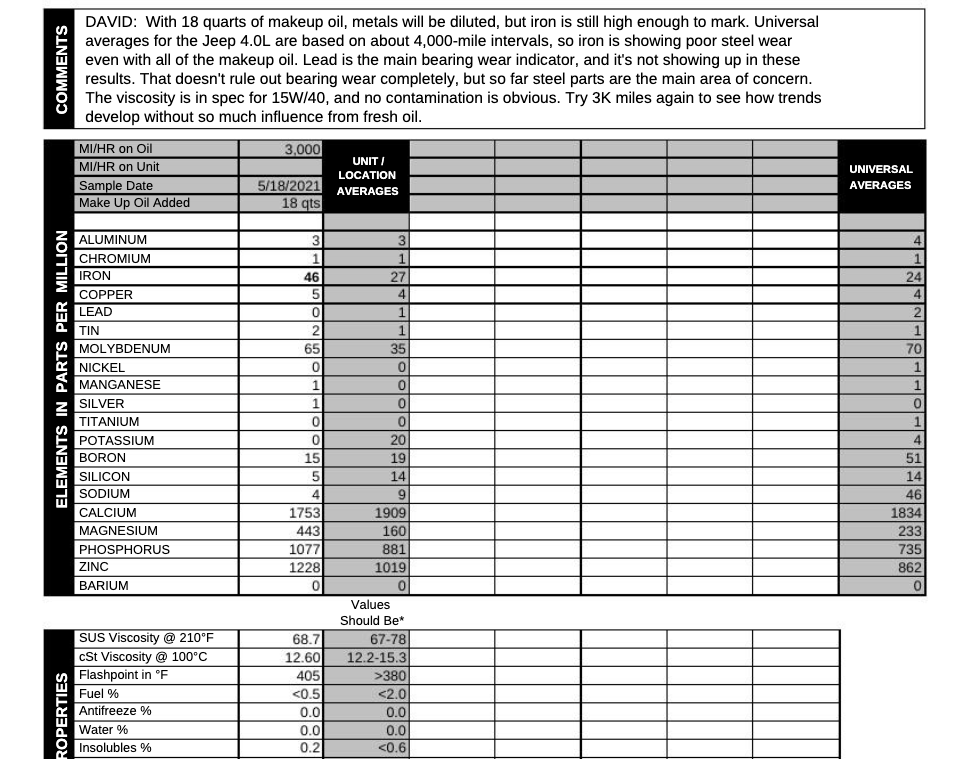
It appears that there was quite a bit of iron in the sample. Forty-six parts per million, to be exact, and that's in oil that's been diluted with over five gallons of fresh oil. It's safe to say that, were it not for the dilution, that PPM figure would be much higher. A typical 4,000 mile oil change interval sample out of a Jeep 4.0-liter inline six has 27 PPM of iron. So clearly, quite a bit of iron wear resulted from the oil starvation. This aligns with he iron filings I found in the filter media.
Here's Blackstone's summary:
DAVID: With 18 quarts of makeup oil, metals will be diluted, but iron is still high enough to mark. Universal averages for the Jeep 4.0L are based on about 4,000-mile intervals, so iron is showing poor steel wear even with all of the makeup oil. Lead is the main bearing wear indicator, and it's not showing up in these results. That doesn't rule out bearing wear completely, but so far steel parts are the main area of concern. The viscosity is in spec for 15W/40, and no contamination is obvious. Try 3K miles again to see how trends develop without so much influence from fresh oil.
Comparing Wear To Another 4.0-Liter Engine
There are lots of factors that go into engine wear, so I should recognize that there's limited utility in comparing two distinct engines that have been maintained and driven differently and in different conditions. Still, I have a 1994 Jeep Grand Cherokee five-speed that is mechanically identical to the 1993 that suffered the oil starvation. I figured tearing into the '94's oil filter might at least give me an idea of how dirty a healthy motor's filter should look.
This could help me understand how alarmed I should be at all of those black iron filings in my '93's paper media. The Blackstone oil report says my engine's iron wear is high, but because the oil was diluted, it's hard to know how high. It's likely that my sample was mostly clean oil added after or shortly before Bradley fixed the oil leak. The oil filter should have captured most of the iron from the oil — even from the oil that leaked. So this should give me a better idea of engine wear severity than the report does.
First, let's establish that my '94 engine, which has 265,000 miles on it, is healthy. It is, per a Blackstone report:
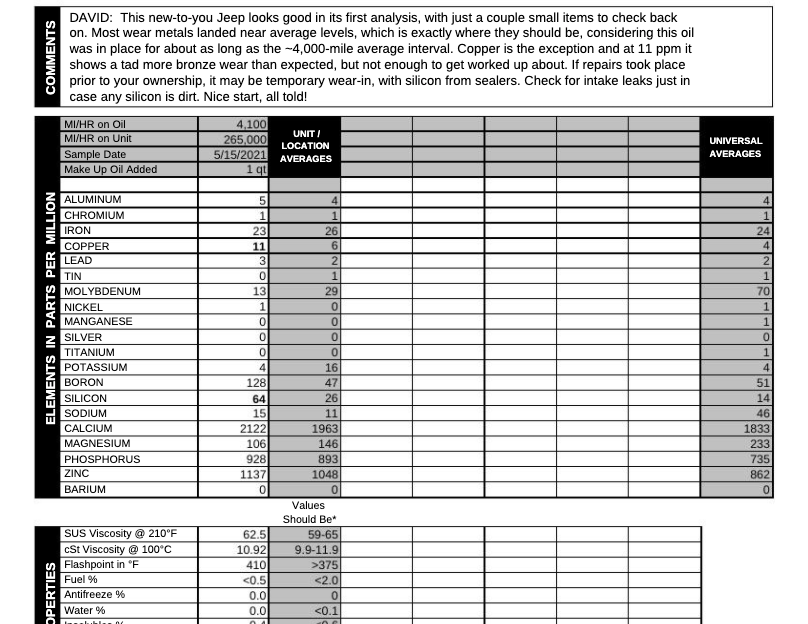
There's a little more copper (bearing) wear than in a typical Blackstone sample, and I'm assuming part of that is a result of elevated silicon levels, which are usually caused by intake leaks allowing sand/dirt into the engine. Still, there's nothing really alarming about this oil sample, as Blackstone says in its summary:
DAVID: This new-to-you Jeep looks good in its first analysis, with just a couple small items to check back on. Most wear metals landed near average levels, which is exactly where they should be, considering this oil was in place for about as long as the ~4,000-mile average interval. Copper is the exception and at 11 ppm it shows a tad more bronze wear than expected, but not enough to get worked up about. If repairs took place prior to your ownership, it may be temporary wear-in, with silicon from sealers. Check for intake leaks just in case any silicon is dirt. Nice start, all told!
Looking at the filthy filter all but confirms the cause of the elevated silicon levels: dirt. Sadly, because of this, it's hard to compare what I see to the 1993 Jeep's filter, which seems to contain mostly iron and very little dirt.
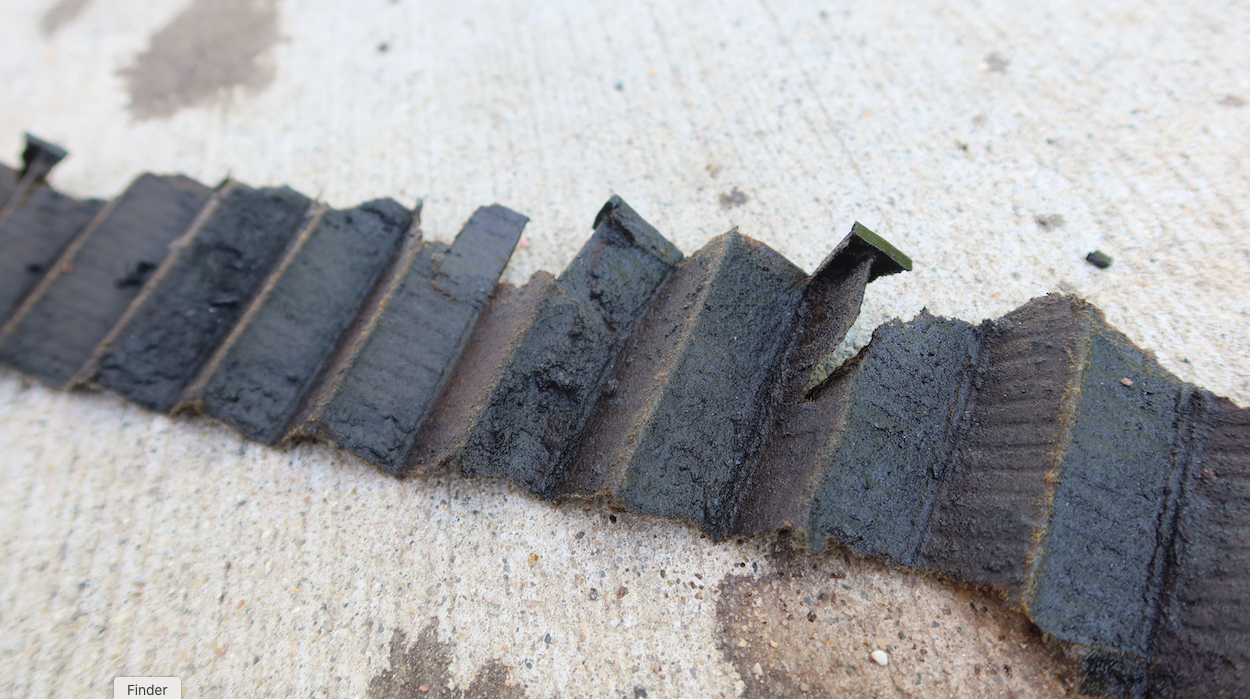
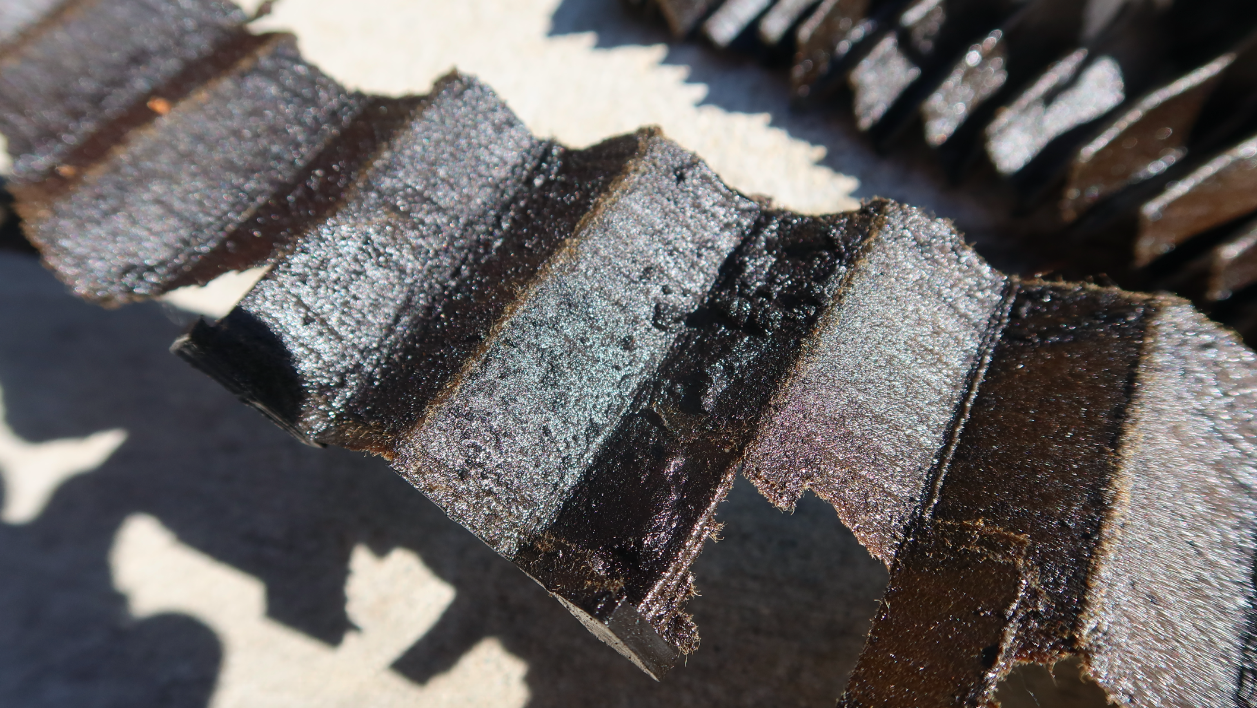
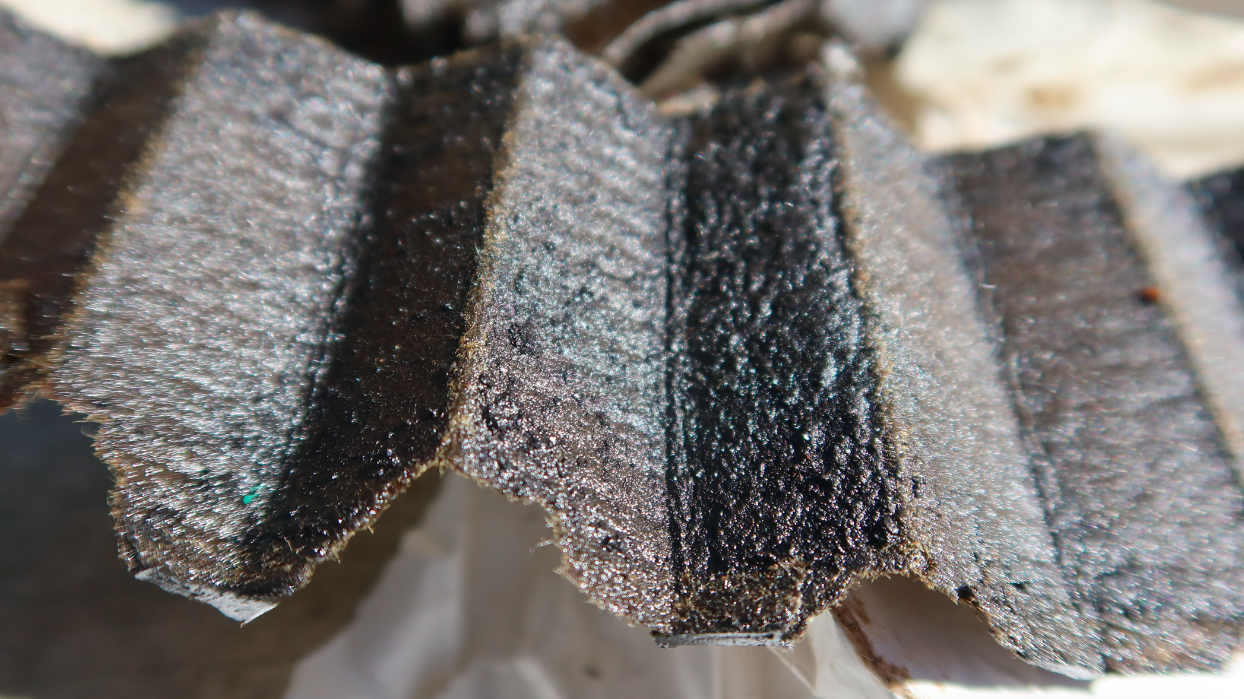
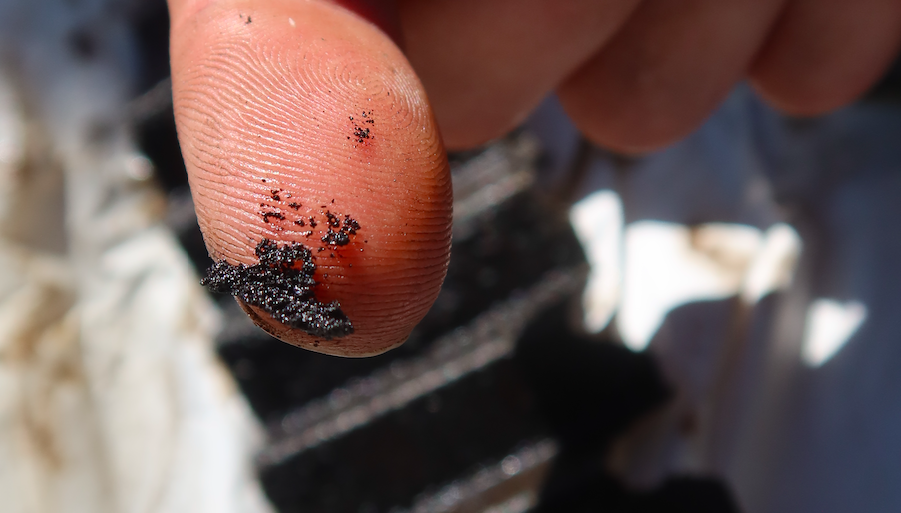
This 1994 Jeep's oil sample contained 23 parts per million of iron — exactly half as many found in the 1993's oil. So you'd expect there to be much less iron in the filter, but that's just not something we can determine given how contaminated the paper media is due to what I suspect was a leaky crankcase ventilation tube (which I've since replaced).
So, long story short: Running the Jeep low in oil almost certainly caused elevated iron parts wear. How bad was it? Well, if we go by the oil that remained in the engine after gallons of make-up oil, it was bad, but not horrible according to Blackstone labs. If we go by what we see in the filter and compared it to what the filter should look like, I bet it'd be worse than just "bad, but not horrible," but I unfortunately don't have a good filter for comparison.
Still, there's more I can do to better understand how damaging this oil leak incident was.
How Can I Tell If I’m Doomed Or In The Clear?
So with that "healthy" engine's filter being contaminated with dirt, making it hard to identify iron, the question is: How worried should I be that my 1993 Jeep's engine ran so low in oil? Well, I chatted with Dr. Andy Randolph, the technical director of ECR Engines — a NASCAR engine developer out of Welcome, North Carolina — and someone with a Ph.D in chemical engineering and loads of experience developing motors (including at General Motors). He and I had a talk about some of the possible failure modes of oil starvation, starting with bearing damage.
Bearings
The first one we discussed is bearing wear, which is generally what you worry about most when you run out of oil. Without an oil "cushion" between rotating components like the crankshaft and connecting rods and their bearings, those components will just wear into the bearings and destroy them in no-time. There are a few ways to tell if you've wiped out your bearings. The first is to send an oil sample to a lab and see how much lead and copper is in there. Blackstone clearly doesn't see a whole lot of those elements in my oil, so that's a good first sign.
The second check is oil pressure. The pressure in an oiling system is generated by the oil pump, but it's a factor of the pressure drop across all flow paths. To help explain this, imagine blowing through a straw and think about the air pressure in your mouth. Now block that straw's end such that you're left with just a tiny hole; the pressure in your mouth is much higher, right?
You can think of bearing clearance as that straw's restriction. With tight clearance between the bearing and rotating parts (again, like the crankshaft, connecting rod, and camshaft), you'll see high pressure in your oiling system. If the bearings have worn away and those clearances become too large, you'll likely see reduced oil pressure.
My Jeep has an oil pressure sender that I just installed to replace the broken one that put us in this mess in the first place. I checked the new sender against a mechanical gauge, and the two read the same, telling me my sender works. Generally, while hot at idle (the best time to test oil pressure is right after pulling off the highway and coming to a stop), I tend to see no lower than 19 or 20 PSI.
The factory spec for the 4.0-liter engine is, per the repair manual, 13 PSI or higher at idle. This tells me my bearings are probably fine.
Piston Rings
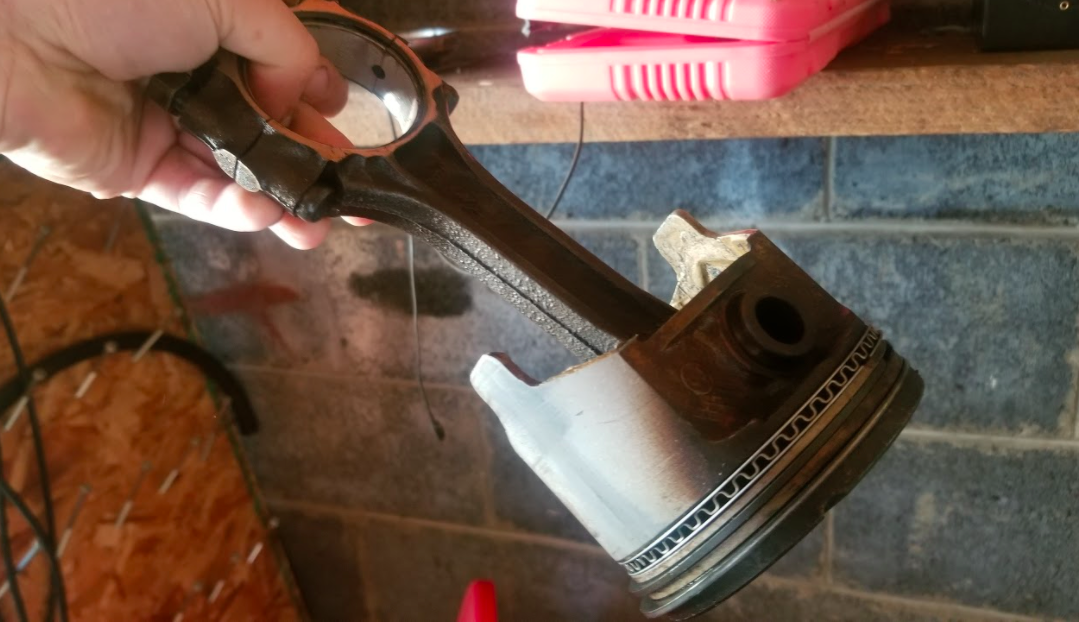
But the iron in the oil has to be coming from somewhere, and that could be either from the piston/bore interface or from the camshaft. Let's talk about the piston/bore interface.
As a piston moves up and down a cylinder bore, its piston rings (two compression rings and an oil control ring) glide on a thin layer of oil. This boundary layer is key to ensuring longevity of the engine, as without it, the rings would ride on the metal bore, creating absurd heat and wear.
Lack of oil can compromise this protective layer, often resulting in scoring in the cylinder walls or piston ring wear. In any case, significant wear at this ring/wall interface will yield reduced compression.
For an internal combustion engine to work, it's got to compress the air/fuel mixture that it sucks in during the intake stroke. If there's a leak path, like a bad valve or worn/broken rings or scored cylinder walls, the engine isn't likely to run well, at least not in the affected cylinder(s).
It follows, then, that a compression test can give a good idea of the health of these potential leak paths (valves, rings/cylinder wall). So I removed my Jeep's six spark plugs and threaded in a compression tester. I removed the fuel pump relay and main coil wire, pressed the pedal all the way down to open the throttle, and cranked the engine over. The pistons sucked in air and compressed it, while my gauge read roughly 130 PSI across all cylinders.
That's an excellent reading, and fits into the "120 PSI to 150 PSI, no more than 30 PSI difference between any two" compression spec mentioned in the repair manual. This tells me that, if there's any ring/cylinder bore wear, it's not that significant.
I'm Scared It's The Camshaft
Did we get away with murder? Did we somehow run this Jeep super low and oil and come out largely unscathed? With the high iron readings on the diluted oil, I remained skeptical.
After talking with Dr. Randolph about my oil pressure and compression readings, he called a friend who's familiar with these engines, and told me his hypothesis. It might be nothing, and the engine is totally fine, he told me. But he does worry that I may have compromised my camshaft.
"If you've worn through the hardness layer on...the cam lobe," he said, "you might want to put in a new filter, drive it for a while, and then pull that filter. It will continue accumulating iron until you notice the performance of the engine start to deteriorate."
"If you've worn through it," he continued, "you'll be able to tell...it'll start making iron actually faster and faster if it's through the hardness layer."
If running this engine on just a few quarts of oil wore through my camshaft's hardened outer layer, the engine "is on borrowed time," Randolph said.
"[The good compression] says it isn't the bore. You've got oil pressure, so [the bearings are probably fine]...all you got left is the cam-lifter interface," he concluded. "It's either that or nothing."
Even a worn cam lobe will still allow valves to close, yielding good compression, Randolph told me. So a compression test isn't going to pick up a bad cam. What's more, because my Jeep uses hydraulic lifters to take up valve lash, I'm not likely to hear increased clearance in the valvetrain, since the lifter can accommodate.
So I just need to drive the Jeep and keep sending in samples. If iron contaminants are high and increasing, then I know this engine is doomed. Or at the very least, it will need a new cam.
